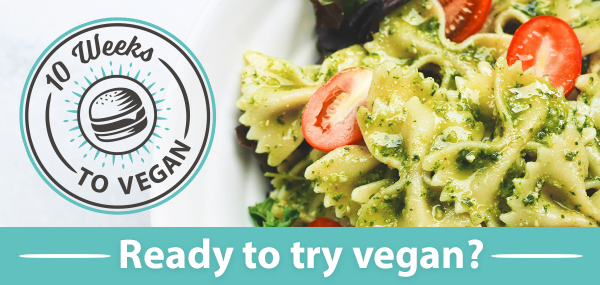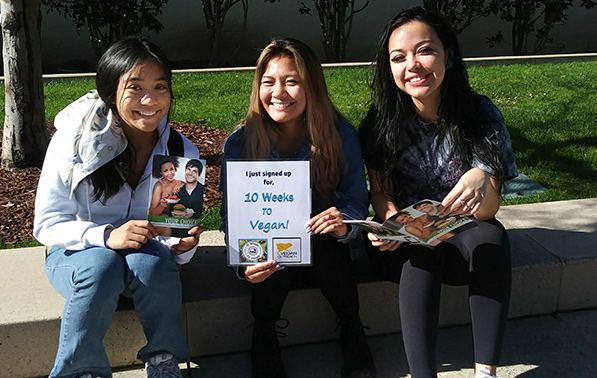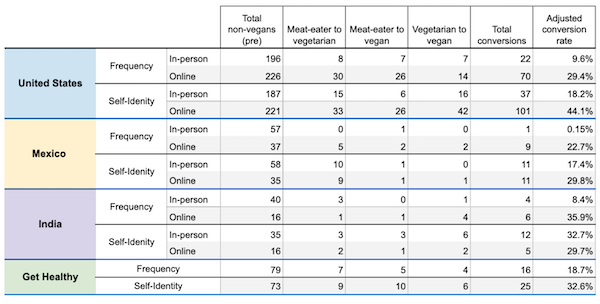
Background
10 Weeks to Vegan is a weekly email series from Vegan Outreach containing tips, recipes, and resources for those interested in learning more about animal-free eating. We’ve adapted versions for several different countries worldwide.
To assess the effectiveness of our program, we surveyed United States, Mexico, and India 10 Weeks to Vegan and Get Healthy participants before and after they began the email series. In order to evaluate long-term change, we sent out a follow-up survey to those in the United States for whom it has been ≥6 months since completing the series.
The pre-test was emailed to participants within a week after they signed up for 10 Weeks to Vegan. We sent the post-test approximately two weeks after people finished the entire 10 Weeks to Vegan series. To encourage participation, we offered two randomly chosen participants per month a $50, $300 peso, or 1,500 INR, respectively, Amazon gift card.
Response Rate
- US pre-test: 7%
- US post-test: 15.5% of those who took the pre-test
- US ≥6-months post-series follow-up: 30% of those who took the post-test
- Mexico pre-test: 10.5%
- Mexico post-test: 10% of those who took the pre-test
- India pre-test: 3%
- India post-test: 10.5% of those who took the pre-test
- Get Healthy pre-test: 9.5%
- Get Healthy post-test: 12.5% of those who took the pre-test

Methodology
We evaluated responses from participants who received 10 Weeks to Vegan, took both the pre-test and the post-test, and reported reading at least one email. In total, we evaluated responses from 500 US participants, 105 Mexico participants, 63 India participants, and 103 Get Healthy participants.
We asked people how often they eat various animal and plant products. The pre-test asks how often participants ate various animal products in the last month and the post-test asks how often in the last week. We follow the food intake questions with a question about whether they identify as a meat-eater, vegetarian, or vegan.
We considered those who moved from being a meat-eater to vegetarian or vegan, or from being a vegetarian to vegan, as a positive change. We classified those who moved in the reverse direction (vegan to vegetarian or meat-eater, or vegetarian to meat-eater) as a negative change. However, anyone whose self-identity was vegetarian or vegan at the pre-test and moved in a negative direction at post-test was cross-checked to see if their diet frequency showed otherwise. We counted the net changes for our total conversion figures.
For people who, based on food intake, misclassified themselves as a vegetarian or vegan in the identity question at pre-test and then reverted to a meat-eater or vegetarian at posttest, we didn’t count their reversal as a net negative. In these cases, we assume that they didn’t understand the definition of “vegetarian” or “vegan” at pre-test but then learned the definition during the series. The conversion rates would be inaccurate if we considered such people as having reverted simply because they learned the definition.
We further adjusted the results to reflect findings from the control group in our past Leafleting Effectiveness Study (LES). The LES asked the same food intake question as our 10 Weeks to Vegan surveys. We found that those in our control group had a conversion rate of 1.6%. Because we would have used this same methodology if we had a control group for our 10 Weeks to Vegan surveys, we subtracted the 1.6% rate from all our net conversion rates to arrive at the final, adjusted rates shown in the table below.
Additionally, we compared the results of those who signed up in-person versus online. In-person sources primarily came from those who signed up through public outreach on college campuses or local events. Online signups came from those who signed up via an online ad or through our website.
We determined p-values using a McNemar test comparing non-vegans at pre-test to total conversions at post-test.
Results
The adjusted conversion rates in the table above show what percentage of participants moved in a positive direction—either from meat-eater to vegetarian or vegan, or from vegetarian to vegan. In all but one instance, those who signed up online showed the greatest change.
All findings for the United States 10 Weeks to Vegan and Get Healthy were statistically significant. All but the in-person diet frequency results for Mexico were statistically significant. Because the pool of respondents from India was relatively small, the findings didn’t reach statistical significance.
Follow-up Results
We followed up with 143 US participants 6 months or longer after they’d completed 10 Weeks to Vegan. The results were very encouraging. There was no statistically meaningful recidivism between the time that they completed the post-test and the follow-up survey.
There was a slight improvement in in-person outreach and a slight decrease in online. The differences between the two were only statistically significant for the self-identity question.
Below are the results from the initial pre-test to the ≥6-month follow-up survey.
Based on this data, it appears that our work is having a lasting effect.
Reasons For Signing Up
Most participants cited multiple reasons for signing up for 10 Weeks to Vegan. Their motivations for signing up for the program fell into a few main categories:
- Health
- Help with transitioning to veganism
- Recipes
- Insight into veganism
- Animal welfare
- Environment
- Reduce animal product consumption
Summary
This research indicates that Vegan Outreach’s 10 Weeks to Vegan series is having a great deal of success in motivating and helping people to become vegetarian and vegan.

